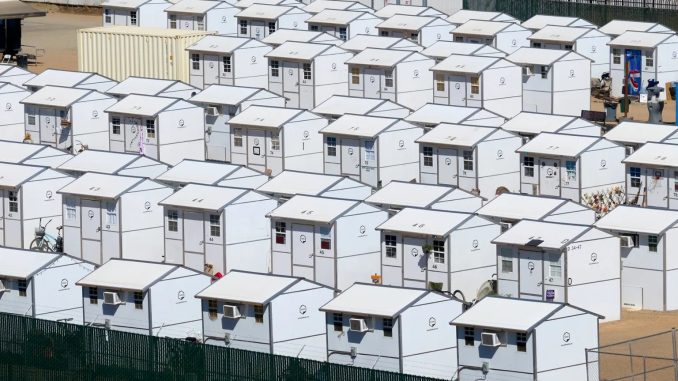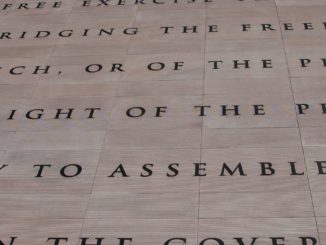
By Jeanne Kuang (for Cal Matters)
CalMatters is an independent public journalism venture covering California state politics and government. For more info, visit calmatters.org.
Cities in the West can’t legally clear encampments unless they can provide adequate alternative shelter to the camp residents. But what, precisely, constitutes “adequate shelter?”
Is it one cot among dozens in a congregate shelter? A top bunk for an elderly person? An individual tiny home? A strip of asphalt, without electricity or water, where rows of people can set up their tents?
The definition is at the heart of debates raging across California in the five years since a federal appeals court ruled that it’s cruel and unusual punishment to evict homeless people from public spaces when they have no other options. The 2018 decision on that Boise, Idaho, case by the 9th U.S. Circuit Court of Appeals, binding on states in the West, did not require cities to set up enough shelter beds for their entire homeless population, but said it would be unconstitutional to criminally penalize people camping in public when they lack “access to adequate temporary shelter.”
Last week a three-judge panel of that same court took another crack at the issue—this time declining to lift a temporary order that has, for nine months, halted San Francisco officials from sweeping the city’s homeless camps.
The most recent order gave San Francisco officials confirmation that the city can sweep sites and cite residents who are “voluntarily” homeless: those refusing legitimate, adequate shelter offers. Officials said they haven’t yet decided whether to do that.
California cities have been itching to get around the technical bounds of the Idaho ruling as constituents with homes complain about encampments in public spaces, citing public health and other concerns. Many local governments say they can ban encampments and that they have the alternative shelter options to enforce it.
Calling it a necessary form of tough love, they’re cracking down on public camps, pairing an offer of shelter—or a stern prodding toward it—with the threat of arrest or fine. San Diego in late July began enforcing a ban on camps in most public places during the day; other cities that have recently passed camping restrictions include Sacramento, San Rafael and Culver City.
Some say the carrot-and-stick approach is too weak a response to flagrant public health and safety concerns on the streets. Others say it’s an infringement on the rights of unhoused people who, if they refuse shelter because of personal circumstances, will get shuffled around town, lose belongings and contact with social workers, or be pushed to more remote or dangerous places to sleep.
In San Francisco, both advocates for the homeless and the city claimed the latest court decision supported their side.
“We are pleased that the 9th Circuit agreed with the City that the preliminary injunction does not apply to those who refuse shelter or those who have a shelter bed and choose to maintain a tent on the street,” City Attorney David Chiu said in a statement.
An attorney for the plaintiffs, a group of unsheltered San Franciscans and the nonprofit Coalition on Homelessness, said that was always the case—but with shelters often near capacity, the city hasn’t shown it is truly providing adequate offers to those on the streets. More than 4,000 people live unsheltered on the streets in San Francisco, while the city has just over 3,000 beds, and notes that not all unoccupied beds are immediately available for someone to be placed.
“The question is, are those people actually voluntarily homeless, did they actually give them a specific offer?” said Zal Shroff, interim legal director of the Lawyers’ Committee for Civil Rights of the San Francisco Bay Area. “The city is representing that 4,000 people on the streets are there by choice.”
Now Gov. Gavin Newsom says the state will intervene, arguing the courts had adopted a “perverse interpretation” of the Idaho case. Newsom, like other Democratic leaders, has blasted the judge’s decision for tying officials’ hands in street cleanups. He said in a Politico forum in September that the state will file a brief supporting the city’s attempt to overturn the injunction.
“I’ve had it. We’re going to intervene,” he said. “I hope this goes to the Supreme Court. And that’s a hell of a statement for a progressive Democrat. But it’s just gone too far. People’s lives are at risk.”
New bans with new tents
In San Diego, police have for months been enforcing a controversial new ban on camps on most public property during the day, or when shelter is available. The July ban prohibits camping near schools or shelters and in parks regardless of whether there’s shelter available. Enforcement coincided with a new “Safe Sleeping site” near a city park as a nod to adequate shelter options.
Though police have also recently ramped up enforcement of an older law banning camps from blocking sidewalks, they say they haven’t yet made an arrest under the new one, instead issuing 85 warnings and four citations in August. Police say they’re employing a progressive strategy by which city staff and then police offer shelter first and issue a warning, then step up to a misdemeanor charge or even an arrest if an unhoused person continues to camp in a prohibited spot.

San Diego Police Capt. Shawn Takeuchi of the Neighborhood Policing Division acknowledges it’s an imperfect approach to the needs of the 6,500 city residents who are homeless any given night this year.
Of those, about 2,600 were in shelter beds. Nearly 3,300 were unsheltered—more than a 30 percent increase from last year. There are about 1,800 city-funded shelter beds in San Diego and about 600 others that are not funded by the city.
“We cannot enforce our way through homelessness; it’s not the proper way to address homelessness,” Takeuchi said.
But for those who refuse a shelter placement or willingly flaunt other laws such as those against public drug use, Takeuchi said, “enough’s enough. Government intervention needs to happen.”
The new “safe sleeping site”—a fenced asphalt lot with 136 tents that fit up to two people each—is located in a city maintenance yard tucked into the southern edge of the storied Balboa Park. The park and areas near schools have been the city’s first enforcement targets.
The city-funded site offers two meals a day, showers and services to help residents with their housing search. Couples can stay together. Folks can stay indefinitely.
It’s a new option in a city that has historically offered only large congregate shelters, which many refuse or find unsuitable. Mayor Todd Gloria said it comes with the “expectation” that more people will choose it over living on the streets when beds are available.
“We have put out a tremendous amount of carrots and we do need a few sticks,” he said. “It is the expectations of taxpayers funding these efforts that folks avail themselves of it.”
As of last week, the site had seven tents open, a spokesperson for Gloria said. The city’s other shelters are all nearly full any given night, said Sofia Cardenas, data and compliance manager at the Alpha Project, a San Diego nonprofit that runs five other shelters.
Neighboring cities have reported increases in encampments in their own borders in the wake of San Diego’s new law, and Cardenas said the nonprofit’s outreach workers are having a harder time finding clients who have scattered around the city.
Takeuchi acknowledged when officers approach a person with a warning or to cite them for violating the camping ban, they don’t necessarily know if there’s a placement for that person’s specific circumstances.
“It’s not as simple as, okay, there’s a bed available for every person we contact because there are certain beds that are not available to certain populations of folks,” he said.
When considering the new ordinance, the city’s attorneys in a legal memo noted that certain shelter options would be inadequate and put the city in danger of violating the Idaho ruling—such as an offer of a top bunk for an elderly or disabled person.
In the first month of enforcement, Takeuchi said out of 85 warnings only three people told police they would agree to a shelter placement, though people who are interested can call the city directly and do not have to accept the offer directly from police.
Cardenas said the city should have increased the number and variety of shelter beds before starting the enforcement, and said existing shelter spaces, including the tent site, may still be inadequate for the elderly or those with disabilities or mental illness.
“Mostly we see people shuffling around,” trying to avoid police, Cardenas said. “When we’re asking them to accept sanctioned campgrounds … is that the best we can do? Accept this, or go to jail?”
Cities contend they’ve been increasing the options. In San Diego, Gloria said officials have another sanctioned campsite planned to open this year that will be able to accommodate up to 400, and have loosened rules on the city’s congregate shelters so that residents can bring in a pet and are not required to be sober.
Mirroring other California politicians on the matter, Gloria criticized activists who call the shelter offerings inadequate as an “infinitesimally small number of voices who seemingly enjoy seeing encampments on the streets.”
“It’s never enough for them,” he said.
‘Better for who?’
Even if shelter spaces are open, unhoused people sometimes opt out.
Under the din of the Highway 99 overpass along the edge of Sacramento’s urban core, a man emerged from his tent on a recent weekend morning and sat at a makeshift breakfast table, shaking a box of cereal.
The man, who would only identify himself as 53-year-old Eric D., said he’d lived at this encampment of about five tents for about a month. His last campsite was a few blocks away near a freeway exit, and highway patrol officers told him he had to leave. The officers had given him a pamphlet with information about social services and shelter; he said “most of the information, a lot of the homeless people already know.”
“Better for who?” he said, when asked whether he would consider a shelter placement better than the encampment. “It depends on the individual.”
Before the freeway exit site, Eric said he’d stayed at a shelter near downtown Sacramento for about two months, but said he got kicked out after missing the curfew three times. The third time, he said he had been staying with relatives while attending a family funeral. Now, he walks or takes the bus two miles from the tent to the community college where he takes classes twice a week, and a social worker visits him occasionally, helping him search for an apartment.
Eric said not all shelter experiences are comfortable and some people chafe at the rules. If he tries one again, he would want it to be near the community college.
“A lot of people are living harder than they need to,” he said of life on the streets. “Me, I can’t stand it.”
His neighbor, Joel Martinez, bagged up trash on the sidewalk before sitting down to light a cigarette.
Martinez, 63, considers himself a caretaker for a friend he’s met on the streets. She lives around the corner in a van, and that morning she was leaning on its hood partially clothed, chattering to herself. Martinez worries about leaving her alone.
“She talks to people we don’t see or hear,” he said. “People were taking advantage of her. I don’t know if she’d fit in at a shelter.”
Still, Martinez said, he’s trying to talk her into moving indoors or to a sanctioned campground with him.
He said he understands why cities are moving to ban encampments, and said not all residents keep their camps clean, though some, he said, “police ourselves.”
“I know people don’t like to be reminded of the homelessness,” he said. “But it’s here, and it seems like the COVID thing really brought it all out.”
Asphalt next to an airport doesn’t count
Federal courts have rarely defined the adequacy of specific types of shelter—though in one extreme case a judge said some things simply don’t count.
In Chico, a group of homeless residents sued the city in 2021 over its enforcement of a ban on camping on any public property. At the time, the city had 120 congregate shelter beds (capacity was diminished during the pandemic) and more than 570 unsheltered residents.

In response to the suit, officials opened a temporary sanctioned campground that summer where residents were allowed to park trailers or pitch tents. The city said it could accommodate its entire homeless population.
Federal District Court Judge Morrison C. England—upon finding that the campground was a strip of asphalt alongside the local airport on the outskirts of town, with one awning erected for shade—was unconvinced.
“This raises the question, ‘What is shelter?’” he wrote, before quickly dismissing Chico’s “asphalt tarmac with no roof and no walls, no water and no electricity.”
Chico officials closed the airport site after less than three months, and last year settled the suit by agreeing to build a “pallet shelter”—177 tiny homes—where those who are camping in a prohibited spot can be directed by outreach workers or police.
Under the settlement, when the city plans to sweep a camp, it must count the number of people living there and confirm there’s enough open shelter beds for them, then notify the plaintiffs’ attorneys and conduct outreach to offer the residents shelter in a process that could take 17 days.
More than 300 people have stayed at the new site since April, either because the city was about to sweep their campsites or because they called the city shelter intake line themselves, said Amber Abney-Bass, executive director of the nonprofit Jesus Center which is contracted by the city to run the site. More than 140 of them left either for violating program rules or not returning to their bed for 72 hours, prompting the shelter to give the slot to somebody else, she said. Fourteen have moved on to more stable housing.
Abney-Bass said she’s glad the case caused the city to create more beds, but she’s wary that as congregate shelters fall out of favor, some will remain on the streets believing “nothing else is good enough” compared to a tiny home placement.
Her nonprofit has assessed more than 100 other people living on the streets since the settlement who have refused a shelter placement if they couldn’t get into the tiny homes site.
Waiting for more judicial guidance
In another case, in Sacramento, a federal judge has temporarily halted encampment sweeps during heat waves twice since last year, after advocates pointed out in court that the city had been directing unhoused people to a sanctioned campground on unshaded asphalt. The site, city attorney Susana Alcala Wood said, does have meals, showers, restrooms and social services.
The city has asked the 9th Circuit to weigh in.
“In order to advise my client as to what constitutes sufficient shelter, I need the court to tell me,” Alcala Wood said.
For the most part, Sacramento has not issued criminal citations against unhoused people violating new camping restrictions passed last year, including bans on camping near schools or for blocking sidewalks. Instead, assistant City Manager Mario Lara said city workers focus on “voluntary compliance,” which does include ordering people to move their tents.
That’s drawn the ire of residents and other local politicians who want camps cleared faster and more frequently. Sacramento County District Attorney Thien Ho has threatened city officials with legal action if they don’t more aggressively enforce the camping bans.
Whether California’s shelter options are “adequate” alternatives to encampments remains an open question. Will Knight, decriminalization director at the National Homelessness Law Center, who opposes the bans, said that’s the next legal frontier for cities hoping to enforce camping restrictions.
Knight defines adequate shelter as accommodating of the personal reasons someone might refuse a traditional shelter bed—including proximity to their children’s school, transportation options or wanting to stay with a pet or partner.
“It has to be done from an extremely humane and individualized level,” he said, of enforcing camping bans.
Meanwhile, the Idaho ruling undergirding the debate may go before the Supreme Court. The Oregon city of Grants Pass, after losing its bid to enforce its camping ban in a similar case before the 9th Circuit this year, has appealed to the high court.
Alcala Wood, of Sacramento, said she’s among a number of city attorneys who plan to sign on to a brief asking the U.S. Supreme Court to weigh in.
“Is a shelter not adequate if it doesn’t provide a place for your pets? Is a shelter not adequate if it doesn’t provide a place for you to store all your excess personal belongings?” she said, ticking off cities’ questions about their obligations. “Should we allow a person to be able to cook in a shelter? What about open flames? These are all questions we do not have the answers to.”




Be the first to comment